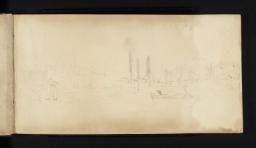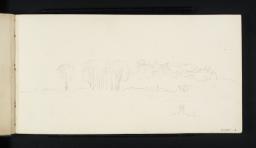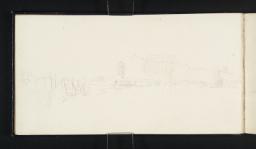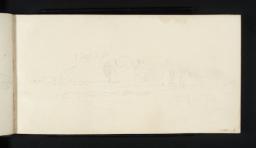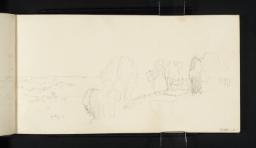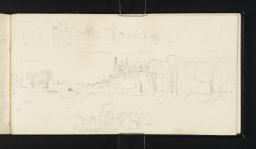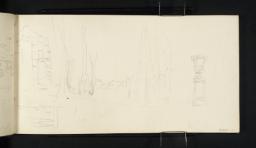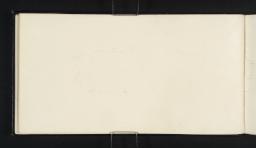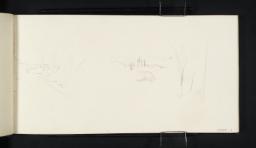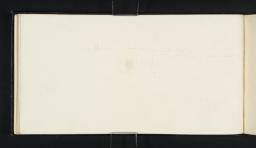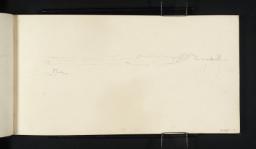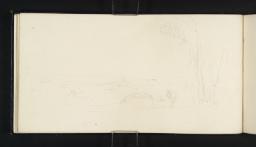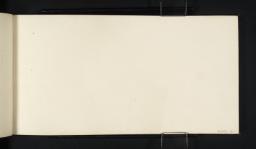Turner Bequest CCXXV 1–30a
Sketchbook bound in boards, covered in dark blue-green leather with narrow borders gilt-tooled with running leaf motif; leather pencil loops along top and bottom edges of back cover
30 leaves and paste-downs of white wove paper; various leaves watermarked ‘Whatman | [Tu]rkey Mills | 1819’; page size 116 x 222 mm
Supplied by Smith, Warner and Company, London; stamped in black ‘SMITH WARNER & CO 211 PICCADILLY’ inside back cover, bottom right, upside down
Blind-stamped with Turner Bequest monogram on front cover, top left
Numbered 333 as part of the Turner Schedule in 1854 and endorsed by the Executors of the Turner Bequest inside front cover, in ink by Charles Turner ‘No-333- Contains 12 leaves Pencil Sketches | C Turner’ at top, and in pencil by Charles Lock Eastlake and John Prescott Knight ‘C.L.E. and ‘JPK’ towards top centre
Blind-stamped with Turner Bequest monogram inside front cover, towards top centre
Inscribed in pencil ‘CCXXV’ inside front cover, top left
Stamped in black ‘CCXXV’ inside front cover, top left
30 leaves and paste-downs of white wove paper; various leaves watermarked ‘Whatman | [Tu]rkey Mills | 1819’; page size 116 x 222 mm
Supplied by Smith, Warner and Company, London; stamped in black ‘SMITH WARNER & CO 211 PICCADILLY’ inside back cover, bottom right, upside down
Blind-stamped with Turner Bequest monogram on front cover, top left
Numbered 333 as part of the Turner Schedule in 1854 and endorsed by the Executors of the Turner Bequest inside front cover, in ink by Charles Turner ‘No-333- Contains 12 leaves Pencil Sketches | C Turner’ at top, and in pencil by Charles Lock Eastlake and John Prescott Knight ‘C.L.E. and ‘JPK’ towards top centre
Blind-stamped with Turner Bequest monogram inside front cover, towards top centre
Inscribed in pencil ‘CCXXV’ inside front cover, top left
Stamped in black ‘CCXXV’ inside front cover, top left
Accepted by the nation as part of the Turner Bequest 1856
References
This sketchbook comprises a few studies made on the River Thames around Windsor and about eight miles down the river to the south-east at St Anne’s Hill, the home of the late politician Charles James Fox near Chertsey in Surrey; some seventeen leaves in the middle of the book have been left blank. In the context of work over many years up and down the Thames Valley, Turner had long been familiar with Windsor Castle and nearby Eton College,1 making a careful watercolour interpretation of Paul Sandby’s view of the school in about 1787 (Tate D00003; Turner Bequest I C), and first drawing the castle directly in about 1792 (Tate D00118–D00120; Turner Bequest VIII D, E, F).
Finberg dated the present sketchbook to about 1827, and David Hill has concurred,2 mentioning it together with the Windsor and Cowes, Isle of Wight sketchbook (Tate; Turner Bequest CCXXVI) in relation to the watercolour Windsor Castle of about 1828–9 (British Museum, London),3 engraved in 1831 for Turner’s Picturesque Views in England and Wales (Tate impressions: T05086, T06093); see also the related ‘colour beginning’, Tate D25156 (Turner Bequest CCLXIII 34). The view of Eton College on folio 4 verso (D20564) was likewise the source of the watercolour Eton College of about 1829 (currently untraced),4 engraved for England and Wales in 1831 (Tate impressions: T04576, T04577). Both the Windsor and Eton views have close contemporary equivalents in watercolour designs by William Daniell (1769–1837), aquatinted in about 1827 for the series Select Views of Windsor Castle and the Adjacent Scenery, a set of which is in the Royal Collection; see under folios 2 verso and 4 verso (D25560, D20564).
In terms of Turner’s Windsor Castle studies in the present book, after a slightly more distant view on folio 1 recto (D20558) the sketches on folios 2 recto and verso and 3 recto (D20559–D20561) record similar but not identical permutations of the castle beyond the river and trees as arranged in the England and Wales composition. By accident or design, the three latter sketches have direct counterparts (even as to their respective folio numbers) among those of Windsor and Eton on the early leaves of the slightly smaller Windsor and Cowes book: Tate D20598–D20600 (Turner Bequest CCXXVI 2, 2a, 3). All of the six sketches show the trees in the middle distance, hatched and shaded to varying degrees, presumably in full leaf against light from the south. There are indications of cloud in the Windsor and Cowes drawings, and also of the morning sun in D20600, as seen in the watercolour, whereas the skies in the three Windsor and St Anne’s Hill sketches are blank.
Self-evidently, such comparable drawings in two different sketchbooks were either done on the same visit, or on similar walks beside the Thames on two separate occasions, but there do not seem to be enough differences in handling and degrees of detail to make a definitive statement as to which might have come first. The Isle of Wight drawings in the Windsor and Cowes sketchbook do seem to belong to 1827 – the book as a whole is placed accordingly with other Cowes material of that year in the present catalogue – and the Windsor and Eton subjects in the first few pages there are interspersed with marine subjects, perhaps suggesting that Turner had used the book along the Thames first. Windsor and Cowes also contains views of Eton College, which appears in the present book on the same page as another view of the castle on folio 4 verso (D20564). In addition it should be noted that there is a sequence of careful views of the lake at Virginia Water, at the south end of Windsor Great Park, in the Kenilworth sketchbook (Tate; Turner Bequest CCXXXVIII). This was mostly used in the English Midlands in 1830, but the lakeside studies seem on the evidence of some incidental architectural details to have been made in 1827 (see under Tate D22113; Turner Bequest CCXXXVIII 71a); Virginia Water is only about three miles west of St Anne’s Hill.
A concurrent dating of the Windsor studies in the present book and those made at and around Charles James Fox’s villa at St Anne’s Hill, above Chertsey (see folios 3 verso–4 recto, 5 recto and verso, 6 recto, 6 verso–7 recto, 7 verso, and 25 verso–26 recto, 26 verso–27 recto, 28 recto, 29 recto and 30 verso; Turner Bequest D20562, D20563, D20565–D20570, D20588–D20593, D20595) might be assumed to be a foregone conclusion given the sites’ proximity. However, they could just as well have been drawn on separate visits from London, and the date of the commission for Turner to make illustrations of St Anne’s Hill for Samuel Rogers’s Poems is unclear, as discussed below. Of these sketches, those relating most directly to the two published illustrations are on folios 25 verso and 26 recto (D20588, D20589).
Fox (1749–1806)5 was a brilliant but controversial Francophile Whig politician and bon viveur, educated at Eton and Oxford (although the presence of an Eton view in this sketchbook appears fortuitous). He held various parliamentary seats and positions including Foreign Secretary, albeit his career was spent largely in opposition. In 1795 he secretly married Elizabeth Armitstead (1750–1842), a former mistress of the Prince of Wales (later George IV), having been involved with her since about 1782; he only revealed that they were married in 1802 so that they could be presented to Napoleon in Paris as husband and wife (during the brief period of peace when Turner visited the Alps and Paris). They had soon begun occupying a villa at St Anne’s Hill, which Fox first rented and then bought in 1784 from the Duke of Marlborough; here they lived, exclusively so from 1798, reading, gardening and exploring the countryside, as well as entertaining: their friends’ phrase ‘to Charley it’ indicated their pleasure at being invited there. Fox died in London and was buried at Westminster Abbey in 1806, and continued to be commemorated by the Fox Club and many other admirers throughout the nineteenth century. His wife remained at St Anne’s Hill, tending the garden, and Turner presumably had her blessing to draw there. The house is also shown in an 1822 watercolour by John Hassell (1767–1827) among a series of Surrey country seats (Surrey History Centre, Woking).
Luke Herrmann has noted the friendship between Fox and the poet and banker Samuel Rogers (1763–1855), which is expressed in part of ‘Human Life’ of 1819 and in ‘Lines Written in Westminster Abbey, October 10, 1806’ (‘After the Funeral of the Right Hon. Charles James Fox’), both of which were included in the 1834 edition of Rogers’s Poems, with engravings after Turner and Thomas Stothard (1755–1834). Two of Turner’s watercolours (Tate D27687, D27688; Turner Bequest CCLXXX 170, 171), published as untitled vignettes on pages 91 and 214, are generally known respectively as St Anne’s Hill (I) and (II)6 and the designs are dated in common with others for the Poems in the Bequest to about 1830–2. Incidentally, these titles probably originated with John Ruskin,7 and were codified in various contexts in the early twentieth century8 with the spelling ‘St Anne’s’, although modern maps and road signs give the spelling as ‘St Ann’s’. It appears that the spellings were formerly interchangeable; Rogers used ‘Anne’; see under folio 26 recto (D20589), and for consistency with the Turner literature this variation has generally been retained in the present text.
The formerly sequestered hill is now largely circumscribed by the M3 and M25 motorways, while below it towards the Thames to the north-east is Thorpe Park Resort, an extensive theme park set around flooded former gravel pits. The site of the Foxes’ house itself is occupied by St Ann’s Court, a Modernist house built on a circular plan in 1936–7 by Raymond McGrath (1903–1977) in collaboration with the garden designer Christopher Tunnard (1910–1979), who lived there subsequently. The scheme was inspired by the surviving eighteenth-century setting the Foxes would have known, by landscape gardener Charles Hamilton (1704–1786), which was remodelled by Tunnard.9 The original gardens included a two-storey flint-faced teahouse (see folio 5 recto; D20565), comprising a grotto set with pebbles and shells and an outside chinoiserie staircase leading to an upper room,10 and a classical Temple of Friendship, built by Fox with an entrance flanked by pairs of Ionic columns. Inside were busts on pedestals,11 including one of Fox by Joseph Nollekens (1737–1823), now on loan to the National Portrait Gallery, London; for the temple, see folios 26 recto and verso and 27 recto (D20589–D20591). The teahouse is now ruined and overgrown,12 and the temple lost its roof in the ‘Great Storm’ of October 1987.13
Herrmann suggests that the Rogers illustrations were not commissioned until the great success of the 1830 edition of his Italy, which had also included illustrations after Turner and others (for the two publications and Rogers in general, see the relevant subsections of Meredith Gamer’s ‘Vignette watercolours c.1826–1843’ in the present catalogue). Thus, according to Herrmann, Turner’s visit to sketch St Anne’s Hill ‘would not have taken place before 1830’,14 although Jan Piggott notes without further comment that ‘Turner is thought to have been at work on the [1834 Poems] designs even before the publication of Italy’,15 and that they were ‘more that four years in preparation’.16 Given uncertainty over the dates of the finished watercolours of both Windsor and St Anne’s Hill, Finberg’s date of about 1827 has been retained throughout.
As Finberg recorded,17 the unaccessioned rear paste-down, otherwise blank, includes the following pencil note by Turner, made at the outer top corner with the page turned vertically:
No 1. -- Edmond [?St]
6 L Brook St –
6 L Brook St –
‘6 L Brook St’ is presumably an address in Lower Brook Street, a colloquial name for the part of Brook Street running west between New Bond Street and Grosvenor Square in Mayfair, in the West End of London, to distinguish it from the officially designated Upper Brook Street, which runs west to Park Lane from the far side of the square.18 Although Finberg read the end of the first line as ‘Edmond St’, the second letter or abbreviated word is unclear, as is its significance, as there appears to have been no Edmond (or Edmund) Street in central London, assuming that it represents the name of a place rather than a person.
Finberg transcribed John Ruskin’s endorsement on a wrapper, since lost: ‘333. Windsor book. 3 leaves out. Some good left.’19
Andrew Wilton, J.M.W. Turner: His Life and Work, Fribourg 1979, p.397 no.829, reproduced, as c.1829; Kim Sloan, J.M.W. Turner: Watercolours from the R.W. Lloyd Bequest in the British Museum, London 1998, p.98 no.30, reproduced in colour p.[99], as c.1828–9.
This account of Fox and his wife is derived from L. G. Mitchell, ‘Fox, Charles James (1749–1806)’, Oxford Dictionary of National Biography, accessed 7 March 2014, http://www.oxforddnb.com/view/article/10024 , and Martin J. Levy, ‘Armitstead, Elizabeth Bridget (1750–1842)’, ibid., accessed 7 March 2014, http://www.oxforddnb.com/view/article/47472 .
Wilton 1979, p.441 no.1188, reproduced, as ‘St. Anne’s Hill I (the house)’, p.443 no.1201, reproduced, as ‘St. Anne’s Hill II (the garden)’.
See ‘Index II’ in E.T. Cook and Alexander Wedderburn eds., Library Edition: The Works of John Ruskin: Volume XIII: Turner: The Harbours of England; Catalogues and Notes, London 1904, p.619 no.228, as ‘St. Anne’s Hill (Front View)’ and no.229, as ‘St. Anne’s Hill (in the Garden)’; the titles listed, as noted on p.609, ‘correspond generally with those on the mounts or frames; they were written by Mr. Wornum and successive Keepers; the identifications were in most cases Ruskin’s.’
Finberg 1909, II, p.902, as respectively ‘St. Anne’s Hill (front view)’ and ‘St. Anne’s Hill (in the garden)’; W[illiam] G[eorge] Rawlinson, The Engraved Work of J.M.W. Turner, R.A., vol. II, London 1913, p.242 no.384, as ‘St. Anne’s Hill. I’, and p.245 no.397, as ‘St. Anne’s Hill, II’.
See English Heritage listing text at British Listed Buildings, accessed 4 March 2014, http://www.britishlistedbuildings.co.uk/en-361727-st-ann-s-court-surrey .
See comparative photographs of the teahouse ‘in better days’ and in its current state at ‘Hoorah for Holland’, Chertsey Museum News, no.36, Summer 2013, p.[1], accessed 20 August 2014, http://chertseymuseum.org/domains/chertseymuseum.org.uk/local/media/images/medium/news36_2.pdf .
See detailed 1990 ‘List entry’ text for the house, garden and garden buildings at English Heritage, accessed 20 August 2014, http://list.english-heritage.org.uk/resultsingle.aspx?uid=1000518 .
Jan Piggott, ‘Rogers’s Poems’ in Evelyn Joll, Martin Butlin and Luke Herrmann (eds.), The Oxford Companion to J.M.W. Turner, Oxford 2001, p.266.
See ‘Brook Street: Introduction’, from ‘Survey of London: volume 40: The Grosvenor Estate in Mayfair, Part 2 (The Buildings)’ (1980), pp.1–2, British History Online, accessed 4 March 2014, http://www.british-history.ac.uk/report.aspx?compid=42099 .
Technical notes
How to cite
Matthew Imms, ‘Windsor and St Anne’s Hill Sketchbook c.1827’, sketchbook, August 2014, in David Blayney Brown (ed.), J.M.W. Turner: Sketchbooks, Drawings and Watercolours, Tate Research Publication, April 2015, https://www

